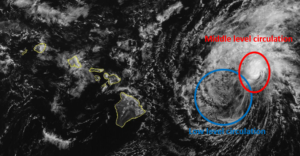Powerful Typhoon Yagi passed south of Hong Kong on Thursday. At 5:00 p.m. EDT on Thursday the center of Typhoon Yagi was located at latitude 19.3°N and longitude 112.5°E which put the center about 230 miles (370 km) south-southwest of Hong Kong. Yagi was moving toward the west at 12 m.p.h. (19 km/h). The maximum sustained wind speed was 150 m.p.h. (240 km/h) and there were wind gusts to 185 m.p.h. (295 km/h). The minimum surface pressure was 923 mb.
The inner end of a rainband wrapped around the original eye and eyewall at the core of Typhoon Yagi and concentric eyewalls formed. The formation of concentric eyewalls ended the intensification of Typhoon Yagi, but Yagi was still the equivalent of a Category 4 hurricane on the Saffir-Simpson Scale.
A circular eye with a diameter of 23 miles (37 km) was at the center of Yagi’s circulation. The eye was surrounded by a ring of thunderstorms and the strongest winds were occurring in that ring of storms. A second outer ring of thunderstorms surrounded the inner eyewall. Bands of showers and thunderstorms were revolving around the core of Typhoon Yagi. Storms near the core of Yagi generated upper level divergence that pumped mass away from the typhoon.
The formation of concentric eyewalls caused the size of Typhoon Yagi’s circulation to increase. Winds to typhoon force extended out 90 miles (145 km) from the center of Yagi’s circulation. Winds to tropical storm force extended out 205 miles (330 km) from the center of Typhoon Yagi.
The Hurricane Intensity Index (HII) for Typhoon Yagi was 31.6. The Hurricane Size Index (HII) was 24.8 and the Hurricane Wind Intensity Size Index (HWISI) was 56.4. Typhoon Yagi was similar in intensity to Hurricane Laura when Laura hit southwest Louisiana in 2020. Yagi is bigger than Laura was.
Typhoon Yagi will move through an environment that will be favorable for intensification during the next 12 hours. Yagi will move over water where the Sea Surface Temperatures are near 30°C. It will move under the middle of an upper level ridge over the South China Sea. The upper level winds are weak near the middle of the ridge and there will be little vertical wind shear. Even though Typhoon Yagi will move through a favorable environment, the concentric eyewalls may prevent Yagi from intensifying. If the inner eyewalls weakens, then Typhoon Yagi could weaken as well. If the inner eyewall remains intact, then Typhoon Yagi could intensify during the next few hours.
Typhoon Yagi will move around the southern part of a high pressure system over China. The high pressure system will steer Yagi toward the west during the next 24 hours. On its anticipated track, the center of Typhoon Yagi will reach northeastern Hainan in 12 hours. Typhoon Yagi is likely to be the equivalent of a major hurricane when it reaches Hainan.
Typhoon Yagi will bring strong winds and heavy rain to Hainan. Yagi will be capable of causing major damage in Hainan. Heavy rain is likely to cause floods in some locations. Typhoon Yagi could also cause a storm surge of up to 14 feet (4.3 meters) along the coast of northeastern Hainan. Yagi will also bring strong winds and heavy rain to southwestern Guangdong and Guangxi.

